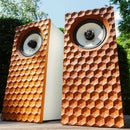Introduction: CNC Dodecahedron Speaker Build
I have wanted to do another speaker project for a while since my last one turned out surprisingly well!
This time though I wanted to go big and make something crazy with my Shapeoko and this is the final write up of how the project unfurled into the final product!
If you like this project please don't forget to vote for me in the CNC contest!
I made all the parts for this project on my Shapeoko 3 but you could do it by hand. It would take a lot longer though I think.
For more projects, check out my other instructables or my Instagram
My last speaker project: https://www.instructables.com/id/Making-a-Beautiful...
Step 1: Design - CAD
All projects start with a design and since I knew that I want to make a dodecahedron I didn't feel the need to do sketches but simply constructed the regular geometric shape in Fusion 360. I normally use Autodesk Inventor but I have heard some good things about the integration of Fusion 360 and Autodesk Cloud Render which I use regularly so why not give it a try!
The speakers I used are some fairly cheap ones from amazon which have a built in tweeter so no need to have to source them separately and organize them around the shape.
I started out with a regular pentagon in Fusion 360 and made it the thickness of my material (20mm White Oak), pocketed a central hole that is just bigger than the main part of the speaker.
Next I cut the chamfers that allow the pieces to fit seamlessly together (in theory). For a dodecahedron the dihedral angle is 116.56 degrees which means each segment must have a chamfer of around 56.28 degrees. I still haven't decided whether I am going to 3d machine this or cut it on my compound miter saw... I also added an oak appearance to the model at this point. It looks so much better in Fusion vs Inventor!
Lastly I pieced everything together to produce a nice render.
I also designed a jig to help align the pieces during the glue up.
Step 2: CAM
I decided not to use fusion 360's built in cam functionality and settled with something I was more familiar with: Aspire.
Aspire is a great tool for 2d work but can be used for 3d as well I have just never got around to learning how to use it.
I set up tool paths for roughing which left about 0.2mm of material behind and then went over each vector again to generate a finishing path which brought the material to final dimensions.
Aspire gives a nice simulation of the tool-path as well so you can check that everything looks good prior to machining.
I was tempted to use Fusion 360's powerful CAM and it would have been quite straight forward considering the designs were done in Fusion already. Perhaps for my next project or when I tackle some aluminium parts I will use Fusion's CAM.
Step 3: Machining
Next came the critical stage of the build, actually machining the hedrals. I started with a prototype out of mdf to make sure all the dimensions were correct, the tool-paths were working and that the general size was about right.
I used a 6mm carbide endmill throughout the machining process as this meant I could run the machine fast and get the pieces made cleanly and quickly.
I can't stress enough how much it helps to have a CNC router to do this, my shapeoko made this project super accurate and made it go way quicker than if I had done it by hand!
In the first machining photo you can see the test piece being machined out of MDF. I used mdf as it is a really inexpensive, fairly soft and dimensionally stable for machining and so is ideal for testing out a job to make sure it works well before moving on to the expensive oak.
After the test was out of the way, i could move on to the oak and just repeat the same thing for all 12 hedrals. (I made one spare as well just in case I messed up further into the project.
Step 4: Post-Machining
Once the hedrals have been cut out by the CNC machine, there are a few things that need to be done before the parts can all be assembled.
First you need to cut the parts out of the offcuts. When doing profile cuts on the CNC that go all the way through the material it is important to use tabs to hold the piece in place for the duration of the machining. These can be cut away easily with a hacksaw blade as shown in the pictures above and the video. Then the remainder of these tabs can be sanded away by hand or using a disc sander as I did.
Step 5: Cutting the Angles and Chamfers
Next, the angles between each hedral needed to be cut and I opted to use the compound mire saw to do this as it was the quickest repeatable way to do it. I could have done it on the CNC machine with a ball nose end mill which would have resulted in a far more accurate joint as my mitre saw is quite cheap and not rigid, but 3d machining the angle on each hedral would have added a lot of time to the machining process.
The decorative chamfers around where the speaker cones would go were cut using a DIY router table I made with an old dewalt trim router suspended under the surface of an old table. This chamfering also removed the inside tabs.
Step 6: Hedral Assembly
At last it came to assembling the hedrals and getting a real sense of what the speaker was going to look like in real life!
Because of the slight inaccuracies caused by the mitre saw, I had to find which pieces fit best where. To help me I made an angle jig on the CNC out of MDF which is shown in the above pictures.
They could then be glued in place once a good fit was found. They were tricky to clamp in place because of the angles but fortunately masking tape came to the rescue and was plenty strong enough to hold them in place whilst the glue dried.
I left one hedral out so I could get inside to install the speaker drivers themselves.
Step 7: Installing the Speakers
To help mount the speakers into their recesses, i used a dab of super-glue around the edge to hold the speaker in place. I then mixed up some epoxy, I found a good trick is to use the extra wide masking tape and stick some down to the table and use that as a mixing pallet. This way you don't have to waste bits of wood or plastic as mixing pallets.
I then dabbed big blobs of epoxy in various places around the rim of the speaker which hopefully stuck it to the oak well. They seemed quite firmly mounted when the epoxy had cured.
It was quite cool to look inside once all the speakers were installed, bar the one that had to be installed last in the opening.
Step 8: Making the Stand
I came up with an unusual geometric stand to match the geometric style of the speaker. It is essentially two copper triangles with vertical supports joining them together. The speaker would then sit with a point downwards inside the top triangle of the stand.
To make these triangles i had to cut the ends of copper pipes at 60 degrees and I thought this would be another great opportunity to use the CNC. I designed a jig that could hold the pipe in place with an indexing point to make sure the cut was right at the end of the pipe.
This worked well and then it was just a matter of soldering it all together with some tee junctions and cleaning it up with wire wool.
Step 9: Finished!
I am very happy with the way this project turned out! I think it looks elegant and although it doesn't sound great due to the quality of the drivers and the fact there are no air ports to bring out the bass in the sound, it still makes an eye catching piece of furniture by itself.
I have managed to use it at a few parties I have hosted and it makes a wonderful conversation starter too so that is a bonus!
If I were to make it again I would probably use the CNC to machine the angles between the hedrals, I had to do a lot of filling and sanding to make the joins seemless but If I had done the angles with the CNC it would be much better than how it was with the mitre saw!
Thanks for reading, and if you enjoyed this please vote for me in the CNC Contest!

Second Prize in the
CNC Contest 2016

Participated in the
Homemade Gifts Contest 2016

Participated in the
Remix Contest 2016

Participated in the
Epilog Contest 8













